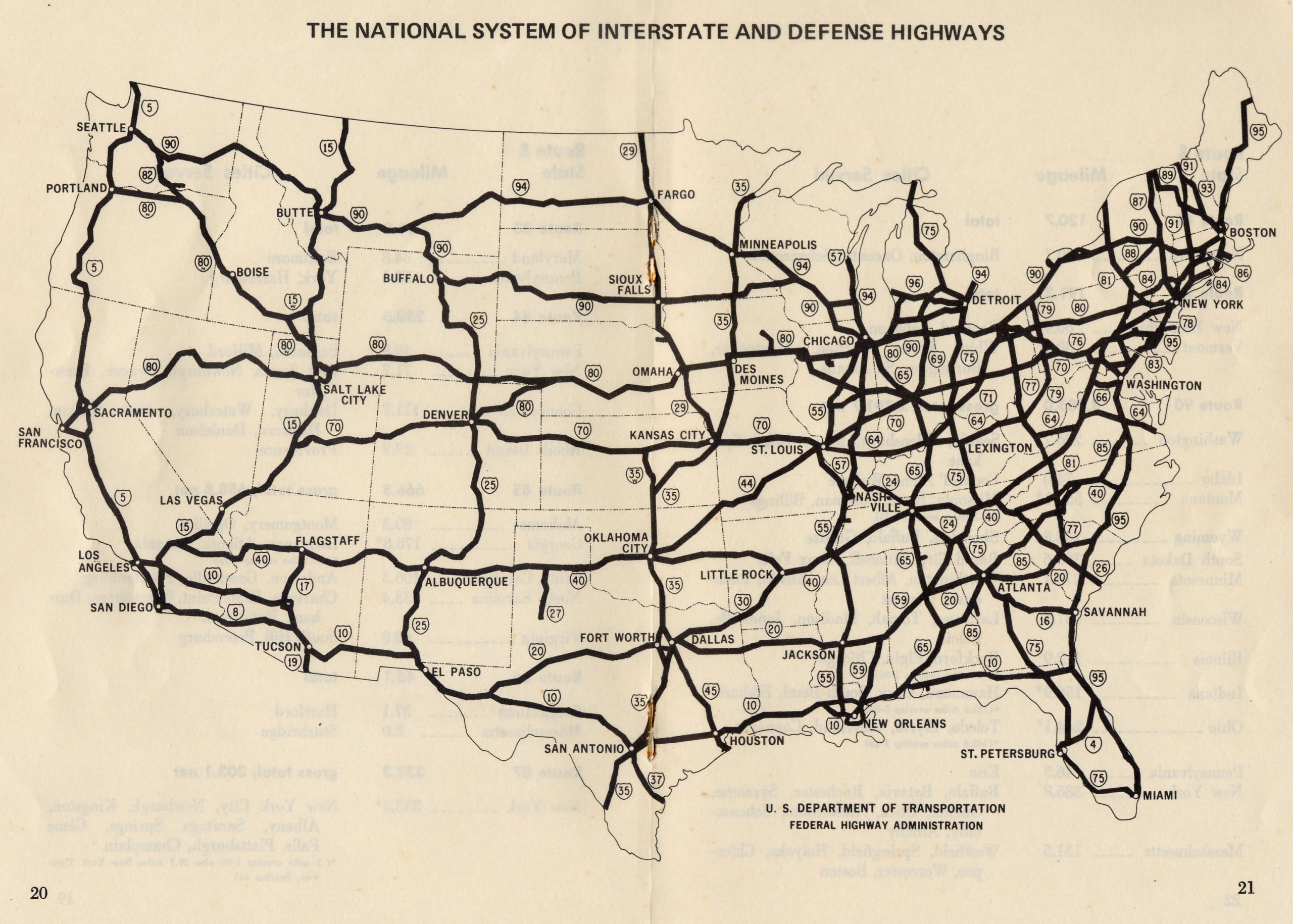Every day, most of us are driving on the most expensive construction project ever to have been completed in the world – the Interstate Highway System. This project is the biggest reason why our country functions the way it does today, and how our economy works. Due to the brilliance of a few men with goals of connecting us together, as well as protecting us, we can travel anywhere in the country with ease. After reading further, you may be more understanding as to why this project cost more than just lots of money.
In 1919, Thomas MacDonald proposed his idea to the government about a ‘system of highways’ that would connect the nation together. Also in 1919, Lt. Colonel Eisenhower joined the 62-day cross country convoy, known as the Motor Transport Corps Convoy, to get a firsthand look as to how the roads worked for long trips. This convoy was put into place due to seeing how the road systems worked in America after seeing how much of an advantage they gave other countries during World War 1. They departed from Washington D.C. and ventured cross country to San Francisco, which proved much more difficult than planned. Most roads were dirt farmland passages, and the convoy got stuck very often. The 3,200-mile trip along the Lincoln Highway took 62 days, and they were using military grade vehicles and equipment! It was this convoy that made it evident our country needed better ways of traveling.
In 1921, the Federal Aid Highway Act (a.k.a. the Phipps Act) was enacted and provided $75 million annually for setting up highways across the nation using MacDonald’s plans that were considered necessary for national defense. This set of highways is seen on the Pershing map, a detailed network of 20,000 miles. As the highways began construction according to this map, the Great Depression came about in the 30’s full force. President Roosevelt viewed the highway system as a tremendous way to employ those all across the country and provided MacDonald an even larger map that he imagined. Eventually, in 1952, Eisenhower became the U.S. President, and changed the new Chief of the Federal Bureau of Public Roads to Frank Turner, a protégé of Thomas MacDonald. Turner continued using the original ideas of MacDonald to begin creating the interstate highway system Eisenhower was envisioning, and soon the Dwight D. Eisenhower National System of Interstate and Defense Highways was born with the 1956 Federal Aid Highway Act.
The interstate highway system totals 48,756 miles and is present in every state, including Puerto Rico. The design of these interstates is actually fairly simple as it follows only 8 rules set by the standards from ‘A Policy on Design Standards – Interstate Systems’. The standards include obvious rules such as speed limits, number of lanes and access areas; and some not so obvious rules such as grading percentages of the shoulders, finding alternate routes, etc. When the highways were just beginning construction in 1956, it cost $8 million to construct 1 mile of highway. Unfortunately, as times continued and the schedule continued to fall behind, prices of labor and materials rose. By the time the system was completed in 1995, it cost $34 million to construct 1 mile of highway. The last section of highway to be completed was also the most expensive section. In Glenwood Canyon, Colorado, the terrain was severe along the Colorado River and required extreme planning and careful execution. Drilling through the mountain and extra bridges and tunnels to accommodate for the different landscape racked up the cost, and ultimately cost $75 million per mile for the 12.5 mile section! The original budget was set for $25 billion, and the schedule was estimated to be 12 years, but resulted in costing $114 billion (now equivalent to $535 billion in 2020) and took 35 years to complete. However, this construction project cost much more than just $535 billion – it cost lives.
While the Interstate Highway System is known as America’s best investment, it caused major issues with the communities that were demolished to make this project possible. The decision on this project resulted from the needs and wants of those who did fight for America but lacked opinion in those who make America. The U.S. Department of Transportation estimates more than 475,000 homes and over 1 million people were displaced due to the highway construction. Many communities were of low-income status, and when their homes and businesses were demolished, they were left homeless and without the essentials to life. Due the areas being low-income the government could save some money as well as resistance from the current resident. However, it’s important to note that many of these communities were people of color and/or religions. Jim Crow Laws continued until 1964, almost 10 years after the beginning of construction. Robert Moses, an infamous urban planner, believed ‘the best way to eradicate black slums [is] to build highways right through them’. It was this ideology that was involved in the 1956 Federal Aid Highway Act that started the construction of the interstate highway system.
For example, Miami was once known as the ‘Harlem of the South’ and ‘Little Broadway’ and had a population of 40,000 people. After the 195 act, 87 acres were destroyed, and only 8,000 people remained in the area. However, due to Jim Crow laws in Florida, black families weren’t allowed to relocate into white neighborhoods, thus creating crowdy neighborhoods that had already been struggling with poverty. Some highways were even built to surround black neighborhoods to prevent them from growing. It became so prominent that the highway system was being largely used for segregation purposes that the phrase ‘No white men’s roads through black men’s homes’ became popular. Detroit is a clear example of how the highways were used for segregation purposes. Black Bottom Detroit was demolished or ‘redevelopment’ even though it was thriving with businesses, physicians, social clubs, music, and so much more. It included Hastings Street which is where Reverend C.L. Franklin, the father of Aretha Franklin, opened the New Bethel Baptist Church. Once the Highway Act was signed and in place, the city was ready to be destroyed and residents had only 30 days to leave. Relocation assistance was minimal to none, and the town was replaced with I-75, I-94, and I-375. On the map, you can see the areas consisting mostly of black population was enclosed by the highways, and completely separated.
Although, the highway system was initially a way to connect people together, it ultimately was used to tear people apart. The cost of this project was much more than the $535 billion, but a cost of people’s living situations, food access, and opportunity. It is an amazing feat of industrial construction as it is one of the most well thought out interstate systems in the world, all the way down to their numbering system. Odd number interstates run north and south, while even interstates run east and west! However, these daily routes were the reason for some people’s misfortune.
If you found this article interesting, feel free to leave a comment below with your thoughts; or share it with your friends and family via the icons below!
Share this Post



